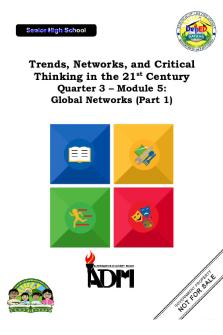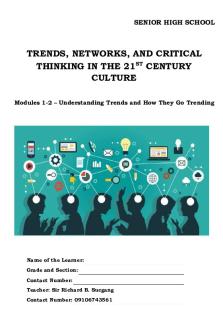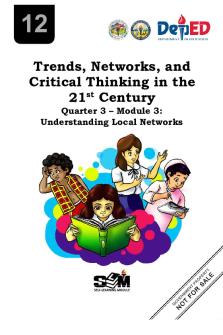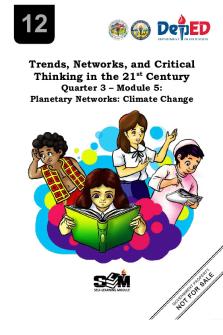Trends Networks and Critical Thinking Module 5 PDF

| Title | Trends Networks and Critical Thinking Module 5 |
|---|---|
| Course | Bachelor of Arts in Sociology (formerly Bachelor of Science in Sociology) (BAS) |
| Institution | Polytechnic University of the Philippines |
| Pages | 24 |
| File Size | 1.1 MB |
| File Type | |
| Total Downloads | 684 |
| Total Views | 924 |
Summary
Trends, Networks, and CriticalThinking in the 21stCenturyQuarter 3 – Module 5:Global Networks (Part 1)iiTrends, Networks, andCritical Thinking in the21####### stCenturyQuarter 3 – Module 5:Global Networks (Part 1)iiiIntroductory MessageThis Self-Learning Module (SLM) is prepared so that you, our dea...
Description
www.shsph.blogspot.com
Trends, Networks, and Critical Thinking in the 21st Century Quarter 3 – Module 5: Global Networks (Part 1)
www.shsph.blogspot.com
www.shsph.blogspot.com
Trends, Networks, and Critical Thinking in the 21st Century – Grade 12 Alternative Delivery Mode Quarter 3 – Module 5: Global Networks First Edition, 2020 Republic Act 8293, section 176 states that: No copyright shall subsist in any work of the Government of the Philippines. However, prior approval of the government agency or office wherein the work is created shall be necessary for exploitation of such work for profit. Such agency or office may, among other things, impose as a condition the payment of royalties. Borrowed materials (i.e., songs, stories, poems, pictures, photos, brand names, trademarks, etc.) included in this module are owned by their respective copyright holders. Every effort has been exerted to locate and seek permission to use these materials from their respective copyright owners. The publisher and authors do not represent nor claim ownership over them. Published by the Department of Education Secretary: Leonor Magtolis Briones Undersecretary: Diosdado M. San Antonio
SENIOR HS MODULE DEVELOPMENT TEAM Author Co-Author – Language Editor Co-Author – Content Evaluator Co-Author – Illustrator Co-Author – Layout Artist Team Leaders: School Head LRMDS Coordinator
: Mary Claire D. Peña : Rodrigo G. Manuel : Princess L. Gamban : Alma F. Garcia : Cherryl D. Cordova
: Omar G. Magcalas : Cherryl D. Cordova
SDO-BATAAN MANAGEMENT TEAM: Schools Division Superintendent OIC- Asst. Schools Division Superintendent Chief Education Supervisor, CID Education Program Supervisor, LRMDS Education Program Supervisor, AP/ADM Education Program Supervisor, Senior HS Project Development Officer II, LRMDS Division Librarian II, LRMDS
: Romeo M. Alip, PhD, CESO V : William Roderick R. Fallorin, CESE : Milagros M. Peñaflor, PhD : Edgar E. Garcia, MITE : Romeo M. Layug : Danilo S. Caysido : Joan T. Briz : Rosita P. Serrano
REGIONAL OFFICE 3 MANAGEMENT TEAM: Regional Director Chief Education Supervisor, CLMD Education Program Supervisor, LRMS Education Program Supervisor, Regional QA Education Program Supervisor, Regional QA
: May B. Eclar, PhD, CESO III : Librada M. Rubio, PhD : Ma. Editha R. Caparas, EdD : Angelica M. Burayag, EdD : Arnold Montemayor
Printed in the Philippines by Department of Education – Schools Division of Bataan Office Address: Provincial Capitol Compound, Balanga City, Bataan Telefax: (047) 237-2102 E-mail Address: [email protected]
i
www.shsph.blogspot.com
Trends, Networks, and Critical Thinking in the st 21 Century Quarter 3 – Module 5: Global Networks (Part 1)
ii
www.shsph.blogspot.com
Introductory Message This Self-Learning Module (SLM) is prepared so that you, our dear learners, can continue your studies and learn while at home. Activities, questions, directions, exercises, and discussions are carefully stated for you to understand each lesson. Each SLM is composed of different parts. Each part shall guide you step-bystep as you discover and understand the lesson prepared for you. Pre-tests are provided to measure your prior knowledge on lessons in each SLM. This will tell you if you need to proceed on completing this module or if you need to ask your facilitator or your teacher’s assistance for better understanding of the lesson. At the end of each module, you need to answer the post-test to selfcheck your learning. Answer keys are provided for each activity and test. We trust that you will be honest in using these. In addition to the material in the main text, Notes to the Teacher are also provided to our facilitators and parents for strategies and reminders on how they can best help you on your home-based learning. Please use this module with care. Do not put unnecessary marks on any part of this SLM. Use a separate sheet of paper in answering the exercises and tests. And read the instructions carefully before performing each task. If you have any questions in using this SLM or any difficulty in answering the tasks in this module, do not hesitate to consult your teacher or facilitator. Thank you.
iii
www.shsph.blogspot.com
www.shsph.blogspot.com
What I Need to Know Welcome to Module 5! In this learning module in Trends, Networks and Critical Thinking in the 21st Century, you will understand the components, operations, effects and networks of globalization in your daily life. Specifically, after working on this module, you should be able to: 1. give examples of various activities in one’s daily life that show the concrete effects of globalization (HUMSS_MCT12If-g-1); 2. explain the concrete effects of globalization to one’s daily life (HUMSS_MCT12-if-g-2); 3. explain the need for collaboration and cooperation to achieve interconnectedness of people and nations (HUMSS_MCT12-if-g-4); and a. show the interconnectedness of people and nations (HUMSS_MCT12If-g-3).
1
www.shsph.blogspot.com
What I Know
FILL IN THE BLANKS Directions: Read each item carefully. Fill each blank with the correct answer. Write your answers on a separate sheet of paper. 1.
_____________________ is a process of interaction and integration among the people, companies, and governments of different nations, a process driven by international trade and investment and aided by information technology.
2.
_____________________ is defined as work, especially hard physical work.
3.
_____________________ refers to social transformation or process leading to the achievement of people-centered development.
4.
______________________ refers to an increasing trend toward multilateralism in an emerging transnational state apparatus, and toward the emergence of national and international nongovernmental organizations that act as watchdogs over governments.
5.
______________________ refers to a body of persons sharing a common religion, culture, or language.
6.
______________________ is a relatively large group of people organized under a single, usually independent government, a country.
7.
______________________ is a collective concept that refers to increasing global linkages created through cross-border financial flows.
8.
____________________ the process of working together to the same end. It is an active help from a person, organization etc. such as an orderly sharing of space and resources.
9.
____________________ is the only global international organization dealing with the rules of trade between nations. The WTO has 164 members and 24 observer governments.
10. ___________________ refers to international capital markets.
an
2
individual
country's
linkages
to
www.shsph.blogspot.com
Lesson
1
Global Networks (Part 1)
Did you know that in the early and late 1980’s, one most popular means of reaching out to loved ones from abroad to their families in the Philippines was through “voice tapes?” You might not be aware of it though, but it takes about a month or months for a taped recorded voice message to be played by their families using cassette tape players. Well, that was prior to our era of today when almost anything can be accessed in real time despite global distance. Now, that gave birth to the present concept of globalization. Generally, globalization was born out of the inter-linkages of nation – states which has in varied ways influenced the life of people worldwide. We might not be able to enumerate the effects of globalization in our daily lives but in this module, it will help you deepen your understanding about globalization. Let us now study the meaning, nature and various activities in one’s daily life that show some concrete effects of globalization. Let’s proceed!
What’s In
Directions: In your previous module you have already understood intuitive thinking and strategic thinking. In this activity I want you to differentiate the two using the diagram below. Write your answers on a separate sheet of paper.
3
www.shsph.blogspot.com
What’s New
Hello! My name is Empress. I am also a grade 12 student. Let us help each other in answering this activity. Let me read the directions for you. “What comes into your mind when you hear the word “Globalization”? Fill in your answers using the concept map. Write your answers on a separate sheet of paper.”
GLOBALIZATION
4
www.shsph.blogspot.com
What is It Globalization As cited in the Revisitadestatica (2012), the term globalization refers to the emergence of an international network, belonging to an economic and social system. One of the earliest uses of the term "globalization", as known, was in 1930 - in a publication entitled “Towards New Education” to designate an overview of the human experience in education. Since the invention of the concept, globalization has inspired numerous definitions and has had a history going back in time to the great commercial and imperialist movements throughout Asia and the Indian Ocean since the fifteenth century. Roland Robertson, a professor of sociology at the University of Aberden, was the first person who defined globalization as "the understanding of the world and the increased perception of the world as a whole." Martin Albrow and Elizabeth King, sociologists, define globalization as "all those processes by which the peoples of the world are incorporated into a single world society. It can be linked to the local, the national and the regional. On the one hand, a connection is made between social and economic relationships and networks, organized on a local or national, on the other hand, it connects social and economic relationships and networks formed on wider scale the regional and global interactions. It is a process of interaction and integration among the people, companies, and governments of different nations. A process driven by international trade and investment and aided by information technology. This process has effects on the environment, on culture, on political systems, on economic development and prosperity, and on human physical well-being on societies around the world. For many developing nations, globalization has led to an improvement in standard of living through improved roads and transportation, improved health care, and improved education due to the global expansion of corporations. However, globalization has had a negative effect on individuals who live in developed nations. Some of the factors that cause globalization are migration and labor. Migration is a movement to another place, often of a large group of people. Labor is defined as work, especially hard physical work. People are more willing to move between different countries today in search for work. Remittances now play a large role in transfers from developed countries to developing countries.
5
www.shsph.blogspot.com
Types of Globalization Economic Globalization is the increasing economic integration and interdependence of national, regional, and local economies across the world through an intensification of cross boarder movement of goods, services, technologies and capital. Examples: • Trans-national trades are companies that extend beyond the borders of one country example of these are Unilever and McDonalds • World Trade Organization is the only global international organization dealing with the rules of trade between nations. The WTO has 164 members and 24 observer governments. • Foreign Direct Investment is an investment in the form of a controlling ownership in a business in one country by an entity based in another country. It is thus distinguished from a foreign portfolio investment by a notion of direct control. In 2019, China and South Korea followed Singapore as the largest investors in the Philippines. Social Globalization is a social transformation or process leading to the achievement of people-centered development. Human-centered development concept is offered as an alternative strategy to bring about a more equity development outcome. Examples: • UN General Assembly • Partnership of International Development Programs • Social Integration, Gender Equity and access to Social Services • HIV/AIDS Awareness Political Globalization refers to an increasing trend toward multilateralism in an emerging transnational state apparatus and the emergence of national and international non-governmental organizations that act as watchdogs over governments. The government has four distinct roles in addressing sustainability concerns. These roles are as follows: 1. Policy development 2. Regulation 3. Facilitation 4. Internal sustainability management Financial Globalization is a collective concept that refers to increasing global linkages created through cross-border financial flows. Financial integration refers to an individual country's linkages to international capital markets.
6
www.shsph.blogspot.com
Technological Globalization is accelerated in large part by technological transmission, the spread of technology across borders. Although the Philippines is not the world's least technologically advanced country, it is far from leading. It ranks 83rd out of 138 countries in terms of technological readiness, according to the Department of Science and Technology (DOST). Ecological Globalization occurs when ecosystems are constantly exchanging materials through the movement of air in the atmosphere, the flow of water in rivers and the migration of animals across the landscape. The world is also becoming highly interconnected through the movement of people and the transport of goods locally to globally (EurekAlert.com). Geographical Globalization is defined as the set of processes (economic, social, cultural, technological, and institutional that contributes to the relationship between societies and individuals around the world. It is a progressive process by which exchanges and flows between different parts of the world are intensified. Let us now identify some positive and negative effects of Globalization. Positive and Negative Effects of Globalization Positive Negative It creates opportunities for countries to The growth of international trade has connect to other countries for larger worsened income inequalities between markets. developed, developing and underdeveloped countries. This can lead to more access capital Global commerce is increasingly flows, technology, human capital, dominated by transnational cheaper imports and larger export corporations which seek to maximize markets. profits without regard for the development needs of individual countries. It allows businesses to become part of Competitions among developing international production networks and countries are races which dangerously supply chains of different countries. lower environmental standards. It allows workers to migrate from their Parents and children can spend a homelands in poorer countries to more decade apart, where they pass their developed countries to find work. responsibilities to grandparents. Technologies are introduced to make a Many developing countries do not have narrower product more efficiently. strict rules about environmental protection, resulting in serious air, water, and soil pollution.
7
www.shsph.blogspot.com
Interconnections of People and Nations Globalization leads to interconnectedness of people and nations, where people refer to a group of people with commonality, such as religion, culture and language who lives in a specific area, while nation refers to a larger group of people organized in a specific place, which embodied an independent government of its country where they can decide on their own. Try to imagine how can we connect to our loved ones especially in this time of pandemic without technologies? Cell phones connect people all over the world like never before. There are a multitude of platforms through which people can communicate too, including Facebook Messenger, WhatsApp, Instagram, and Snapchat. Considering the new normal education, how can we enroll in our online educational programs in school from anywhere in the Philippines without the different platforms and access new information on virtual topics? Collaboration means to work together with others to achieve a common goal. Unconditionally sharing everything and helping each other while mutually working together in cohesive “collective” in unusual roles embracing talents of each person to synergize or invent something new in a way that: a. benefits all the groups, b. serves the whole team’s goal, and c. may result to creative innovation. Cooperation is the process of working together to the same end. It is an active help from a person, organization etc. such as an orderly sharing of space and resources. Cooperation means conditionally sharing information and resources while functioning together within an independent “connective” in typical roles with workloads accepted as unequal to change something in a way that: a. benefits some individuals in a group, b. meets their personal needs, and c. may result in disrupted innovation.
8
www.shsph.blogspot.com
What’s More
Directions: Do the following and write your answers on a separate sheet of paper. 1. Draw the table below. 2. Choose five types of globalization in the discussion above. 3. Give concrete examples of various activities in your daily life that show the concrete effects of globalization. 4. Identify if the given effects are positive or negative. Explain your answer. Type of Globalization
Example
Positive
9
Negative
www.shsph.blogspot.com
What I Have Learned Directions: Complete the following to form sentences by reflecting on what you have learned. You may further explain your answers. Write your answers on a separate sheet of paper. 1. Globalization is ___________________________________________________________ ___________________________________________________________________________ ___________________________________________________________________________ 2. Collaboration is ___________________________________________________________ ___________________________________________________________________________ ___________________________________________________________________________ 3. People are _____________________________________________________________ ___________________________________________________________________________ ___________________________________________________________________________ 4. Technological Globalization is_____________________________________________ ___________________________________________________________________________ ___________________________________________________________________________ 5. Political Globalization is___________________________________________________ ___________________________________________________________________________ ___________________________________________________________________________
Hooray! Let us now assess your learning in this module.
10
www.shsph.blogspot.com
What I Can Do
What’s On Your Mind? Directions: Examine the picture below and answer the following questions. Write your answers on a separate sheet of paper.
1. What does the picture symbolizes? ___________________________________________________________________________ ___________________________________________________________________________ ___________________________________________________________________________ ______________...
Similar Free PDFs

Trends Networks Module 4
- 33 Pages

Mod 5 Critical Thinking
- 2 Pages

Critical Thinking Assignment3-5
- 1 Pages

Critical Thinking Week 5 Notes
- 3 Pages

Critical Thinking Assignment 5-4
- 2 Pages
Popular Institutions
- Tinajero National High School - Annex
- Politeknik Caltex Riau
- Yokohama City University
- SGT University
- University of Al-Qadisiyah
- Divine Word College of Vigan
- Techniek College Rotterdam
- Universidade de Santiago
- Universiti Teknologi MARA Cawangan Johor Kampus Pasir Gudang
- Poltekkes Kemenkes Yogyakarta
- Baguio City National High School
- Colegio san marcos
- preparatoria uno
- Centro de Bachillerato Tecnológico Industrial y de Servicios No. 107
- Dalian Maritime University
- Quang Trung Secondary School
- Colegio Tecnológico en Informática
- Corporación Regional de Educación Superior
- Grupo CEDVA
- Dar Al Uloom University
- Centro de Estudios Preuniversitarios de la Universidad Nacional de Ingeniería
- 上智大学
- Aakash International School, Nuna Majara
- San Felipe Neri Catholic School
- Kang Chiao International School - New Taipei City
- Misamis Occidental National High School
- Institución Educativa Escuela Normal Juan Ladrilleros
- Kolehiyo ng Pantukan
- Batanes State College
- Instituto Continental
- Sekolah Menengah Kejuruan Kesehatan Kaltara (Tarakan)
- Colegio de La Inmaculada Concepcion - Cebu










